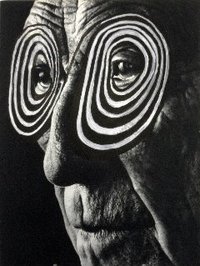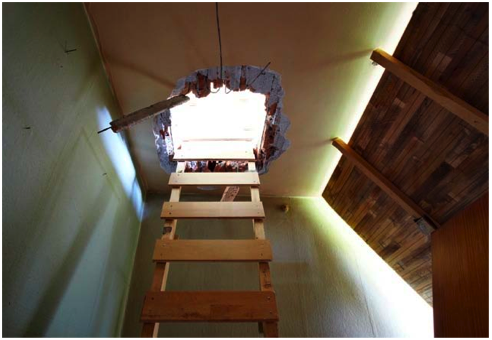Question: There has been a very strong and almost unanimous negative response from Copenhagen to your installation at the Danish Biennale Pavilion. How did you experience this echo?
Tonight I dreamed of Asta Nielsen, she was a cabaret artist and played the Danish Defence Minister in a television speech: “I have to put my soldiers on alert! What foreign artists have done here is not just an embezzlement of Danish taxpayers’ money, it is a declaration of war on our nation! They have received our money! And their thanks? To criticise us! That has never happened before! For the good of our nation we must reclaim our taxpayers’ money! Our soldiers are ready to defend our nation against this shame!” – Asta was great and in her exaggeration she hit the nail on the head. The excitement about the Danish pavilion in Venice is beyond reason.
Question: What is your actual intention with the installation?
My intention was to create a work of art full of intensity that carries within itself the contradiction of being a romantic pavilion, an open place in the green, a place that invites you to linger, but which then, when you enter it, turns out to be an accumulation of enormous conflict potentials. Need and reality collide. As in real life.
Is it about the abuse of freedom of opinion?
Yes, also, as about current tendencies of censorship, but not only. In this work I focus on the general situation in Europe, where there has been a shift in power in the last 20 years: the once marginal right-wing splinter groups have moved to the centres of power, this development is catastrophic. I try to make this development visible and find an artistic answer to it. My work is a reputation: we must put an end to it, we need a fundamental change, an emancipatory departure. I want an open Europe, where we live together on an equal footing with everyone, including immigrants and refugees from other cultures.
Question: Do you, as the media in Denmark have said, want to encourage visitors to step into portraits of politicians?
That’s nonsense, my work “Pavilion for Revolutionary Free Speech” contains a “Speakers Corner” with a large megaphone that every visitor can use for spontaneous speeches, as well as a floor piece. I transformed the entire floor area, approx. 150 sqm, into a woodcut. Fact is, the visitors can enter this woodcut. That is also the special thing, they stand in the middle of the work of art. At their feet are these figures, which are partly equipped with great power. For a brief moment, the visitors experience a perspective that turns the real power relations upside down. Of course, they can determine for themselves how and where they move and position themselves in the picture. It would be a complete contradiction to my way of thinking to give guidelines here. After the exhibition I intend to make a complete impression of the picture, perhaps the traces of the visitors will be visible on it. So the work continues to develop in the sense of a social sculpture.
Question: What do you think when in Danish newspaper commentaries your work is practically consistently dismissed as “flat provo art”, “art of abuse” or “ridiculous”?
Many artists – including well-known ones – have already been confronted with insults of this kind; I would wish for a sophisticated form of controversy. Whoever perceives my art attentively will notice that it is a call to differentiation. 33 portraits – they all have two eyes, a nose and a mouth and yet they all embody individual persons. Curator Bice Curiger or Paolo Baratta, director of the Venice Biennale, a self-portrait of myself, Thilo Sarrazin, Angela Merkel, Pope Benedict. No one can seriously claim that everyone is in the same position and in the same responsibility. Nevertheless, I contradict everyone, only for different reasons.
In view of the fierceness with which my work is attacked in Denmark, it is remarkable that not a single journalist has contradicted it even on one point: the Pope does not clear up the sexual assaults of his priests, instead he agitates inhumanly against homosexuals, Berlusconi has a secretary of state who receives her post after she says she is proud to be a fascist, the Greek government wants to build a fence to Turkey in order to obstruct migrants’ access to Europe…, the Hungarian government reintroduces the censorship of the media…, for me this is all material for resolute contradiction. I think my work of art is making such high waves because it develops fundamental criticism of political conditions in a prominent place with unusual unambiguity.
Question: Denmark’s Minister of Culture Møller has criticised that only two out of 18 artists participating in the Danish Biennale Pavilion are Danes. Can you understand that?
Malte-Bruns would have turned around in his grave and shouted to the minister: “My son, what you’re saying is a disgrace…” The orientation of the Danish Pavilion across national borders is a groundbreaking step. Of course, this does not mean that there are no outstanding artists in Denmark. Maybe one day they will actually be seen in the German, British and certainly in the Danish pavilion. I don’t define myself by “being German”. I found the hospitality of the Danish Arts Council phenomenal and was very impressed.
Question: Has your image of Denmark changed as a result of the public reactions to your installation? How do you experience the climate of debate there in comparison to Germany?
Yes, I am astonished that there doesn’t seem to be any critical, left-wing media that form their own opinion, research and write in a well-founded way. But that fits into the pan-European picture, which confirms to me how important clear signs of protest and resistance are. I hope, however, that they will soon be there again, the fish that swim against the tide, that start a debate on content and oppose the politics of exclusion, mockery and racism.










































